Find Your Climate Action
Use our tool to find actions that are good for you, your community and the planet.

The flesh-footed shearwaters on Australia’s Lord Howe Island are some of the most plastic-contaminated seabirds in the world. This bird was photographed at night under red light.
© Justin Gilligan
Katie Pavid and Emily Osterloff
Off the eastern coast of Australia is an island that looks like a tropical paradise, surrounded by white sand beaches and turquoise seas.
But a grim reality lies behind the idyllic landscapes: the birds that live here are facing death by ocean plastic.
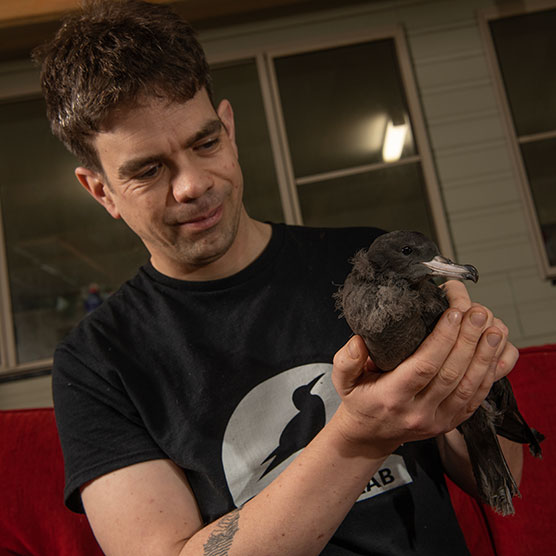
Our Senior Curator in Charge of Birds, Dr Alex Bond, holding a flesh-footed shearwater.
© Justin Gilligan
Warning: this page contains images of dead birds, dissections and stomach contents that some readers may find upsetting.
Head about 600 kilometres out into the Tasman Sea, almost directly east of Australia’s Port Macquarie and you’ll find yourself on Lord Howe Island.
This tiny, World Heritage-listed island is home to just a few hundred people and a breeding colony of tens of thousands of seabirds.
Dr Alex Bond, our Senior Curator in Charge of Birds, has been documenting threats to the island’s bird life since 2009. He’s been working closely with researchers from the Esperance Tjaltjraak Native Title Aboriginal Corporation and University of Tasmania.
For much of this time, they’ve been examining the stomachs of wedge-tailed and flesh-footed shearwaters. Flesh-footed shearwaters – alternatively known as sable shearwaters – are the most plastic-contaminated bird species in the world.
The contents of the birds’ digestive tracts are a shocking sight. They’re filled with countless large chunks and shards of plastic.
There are even identifiable items. Alex’s many finds include balloon clips, pieces of LEGO, biro lids, bottle tops and wheels from a toy car.

A collage of plastic. Researchers removed these pieces of plastic from the guts of shearwater chicks.
© Justin Gilligan
Shearwater chicks that should be getting a diet of fish and squid are instead accidentally fed meals of plastic by their parents.
“The chicks are in their burrows for 90 days,” says Alex. “The parents lay one egg a year and that hatches in late January. The parents then spend the next three months going out into the Tasman Sea, collecting food or plastic, bringing it back and feeding the chick.”
The team once found a record 64 grams of plastic, made up of 274 pieces, in one shearwater chick. In another in 2023, they counted a staggering 405 pieces of plastic.
Plastic can account for 5–10% of the chick’s total bodyweight and all that material leaves no room for real, nutritious food. It amounts to a death sentence for the bird.
“The flesh-footed shearwaters are affected particularly badly, and we don’t fully understand why,” says Alex.
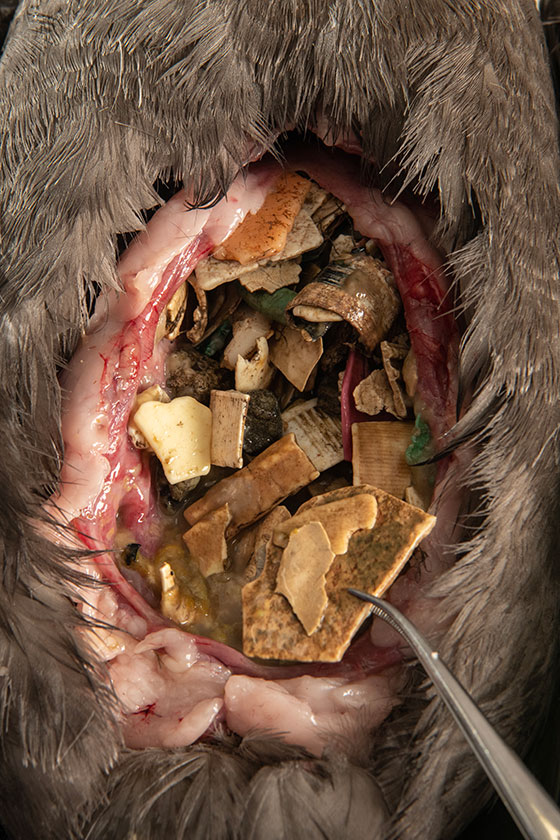
A necropsy on a shearwater reveals a stomach filled with plastic.
© Justin Gilligan
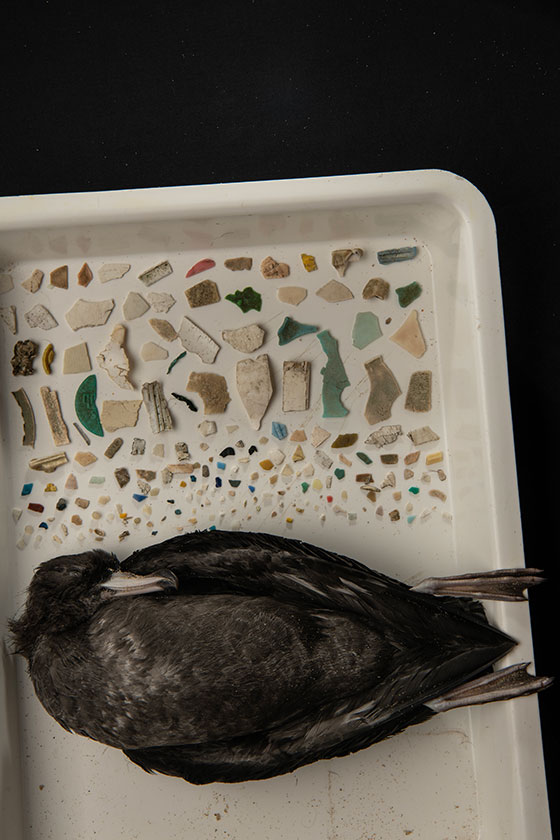
A flesh-footed shearwater lies next to the plastic pulled from its belly.
© Justin Gilligan
“It can be difficult to know whether a bird has been killed as a direct result of ocean plastic because its effects can be insidious. A chick with a stomach full of plastic is clearly going to have a hard time surviving, but there are other threats too,” explains Alex.
“Plastic can absorb toxins in the ocean, land in a bird’s stomach and release those toxins into the bloodstream – but this isn’t an obvious problem to the naked eye.”
“A microbead can pass through a bird’s gut, but it leaves a trail of toxins behind.”
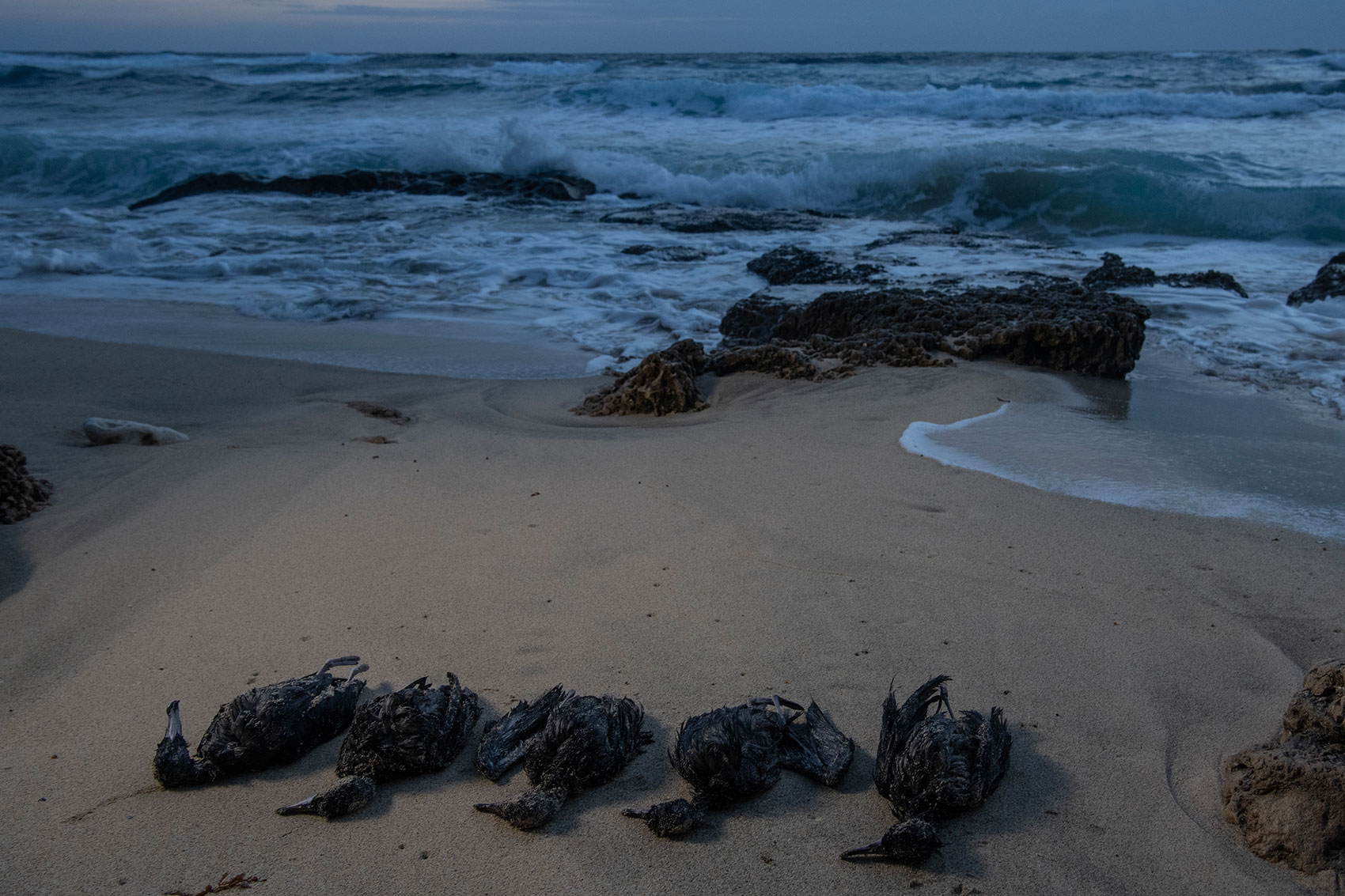
Five dead shearwaters with waterlogged feathers full of sand found on one of Lord Howe Island’s beaches.
© Justin Gilligan
Alex has been working with colleagues Dr Jennifer Lavers, an eco-toxicologist from the Esperance Tjaltjraak Native Title Aboriginal Corporation and Dr Jack Rivers Auty from the University of Tasmania. They’re also joined by a suite of research students.
The team have been measuring contaminants in the birds’ blood and feathers, as well as studying tissue damage in their internal organs. They can also examine the plastics from inside the birds’ stomach, to find out exactly which toxins have been ingested.
Most mornings when they’re working, Alex, Jack and Jennifer find dead or dying birds on Lord Howe Island’s beaches.
After 90 days in their underground burrow, the little birds fledge and head for the water. Those too weak to face the ocean can be rolled by the waves and drowned.
The scientists take the birds back to their lab and empty their stomachs - and most are full of plastic. The researchers also flush the stomachs of living birds. They do this when the chicks first emerge from their underground burrows, before they make their maiden flight.
They use a technique called lavage. Seawater is gently pumped into a chick’s stomach. The bird coughs it back up and into a bucket. Anything they’ve eaten that’s lodged in their belly comes back up with it.

Back at the lab, Alex measures the beak of a dead shearwater.
© Justin Gilligan

Researchers use a technique called lavage on a shearwater chick.
© Justin Gilligan
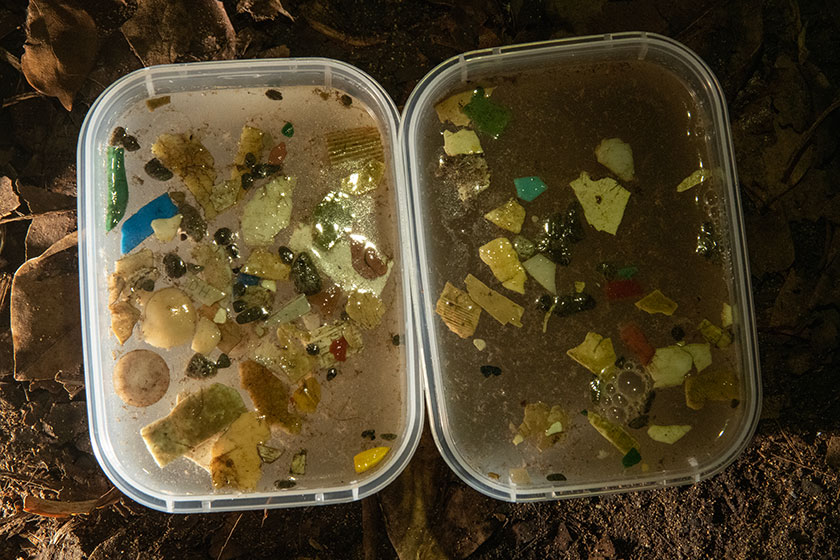
The results of pumping the stomachs of shearwater chicks: water and a lot of plastic.
© Justin Gilligan
“These are chicks that have been accidentally fed all this plastic by their parents. They haven’t even fledged the nest yet by the time this amount of rubbish accumulates in their systems, but they will eventually be expected to migrate from Australia to Japan on their own,” says Alex.
“With that amount of material inside them, many will never make it.”
A stomach full of plastic is as awful as it sounds.
“It’s absolutely horrible,” says Alex. “In severely impacted birds, if you hold it between two hands – around its wings and around the stomach below the ribcage – you can feel the crunching. You can hear the crunching.”

Alex collects a dead flesh-footed shearwater on Lord Howe Island. Most the team find have stomachs full of plastic.
© Justin Gilligan
The plastic pieces store up toxic chemicals that can get into a bird’s gut and blood and affect them in other ways. These effects may not be immediately fatal, but scientists are working to understand exactly how these toxins can change an animal’s life.
In a paper published in 2014, the team examined shearwater fledglings in eastern Australia. They found that birds with the most plastic in their stomachs were in worse shape. They also had higher concentrations of contaminants in their tissues.
“Their stomachs are fantastic organs,” says Alex. “They have all these little folds in them, which basically serve to increase the surface area of the stomach so that the stomach wall can absorb all the nutrients the birds should normally be eating.”
“But when you get plastics in there, you get an inflammatory response.”
In 2023, Alex and his colleagues named this new disease ‘plasticosis’.
The action of plastic repeatedly digging into the bird’s stomach wall causes irritation. As it happens over and over again, it can cause excessive amounts of scar tissue to form. Ultimately, this reduces the flexibility of the stomach tissues and causes their structure to change.
It’s all taking its toll on the seabirds. Recent population estimates show the number of flesh-footed shearwaters on Lord Howe Island has dropped markedly.

Lord Howe Island is home to the biggest colony of flesh-footed shearwaters in the world. But researchers on the island are regularly finding dead birds.
© Justin Gilligan
Not all species are suffering quite as badly.
Wedge-tailed shearwaters are neighbours and close relatives of the flesh-footed shearwaters. They share nesting and feeding sites on Lord Howe Island and in the Tasman Sea.
One of the team’s papers finds that while Australian wedge-tailed shearwaters do eat plastic, they eat far less of it than other species. It also doesn’t appear to have a significant negative impact on their body size.
“Both species eat broadly the same food, breed at roughly the same time of year and feed in or around the same place,” explains Alex. “Yet one is so much more badly affected than the other, and we have no idea why.”
Hear Alex talk about his work and explore more about what our plastic addiction means for the planet in episode four of our podcast.
Seabirds are at the top of the food chain and rely heavily on healthy marine environmentsopens in a new window. This makes them important indicators of the ocean’s wider health.
The work of the team on Lord Howe Island proves that we need far more research into the effects of plastic ingestion on animals living in a range of marine habitats.
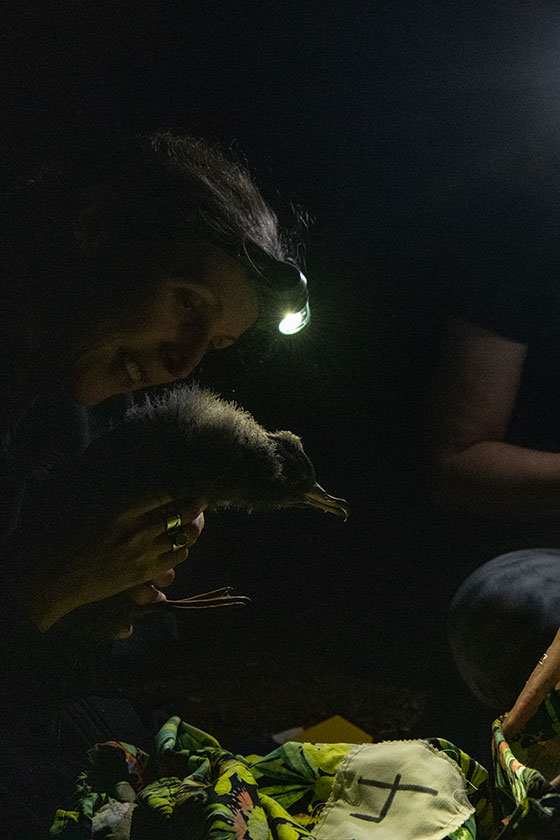
The team on Lord Howe Island checks the condition of a young shearwater.
© Justin Gilligan
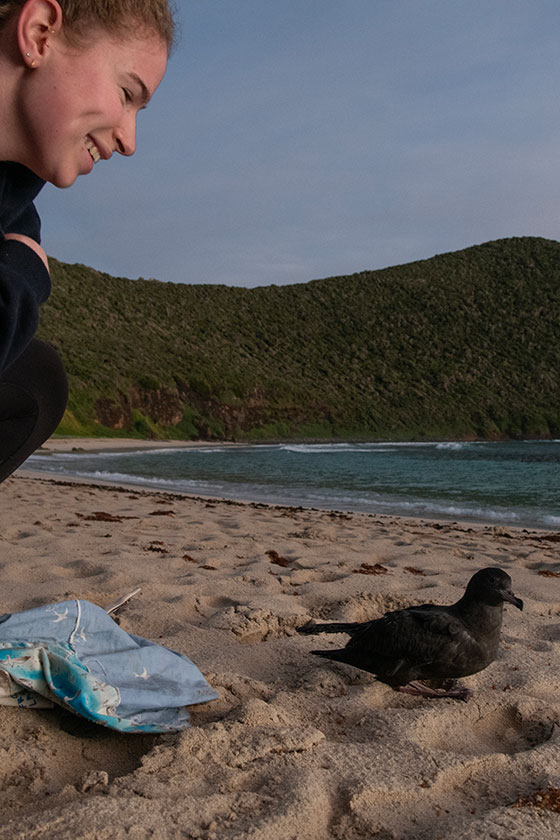
A rehabilitated shearwater is released to the ocean.
© Justin Gilligan
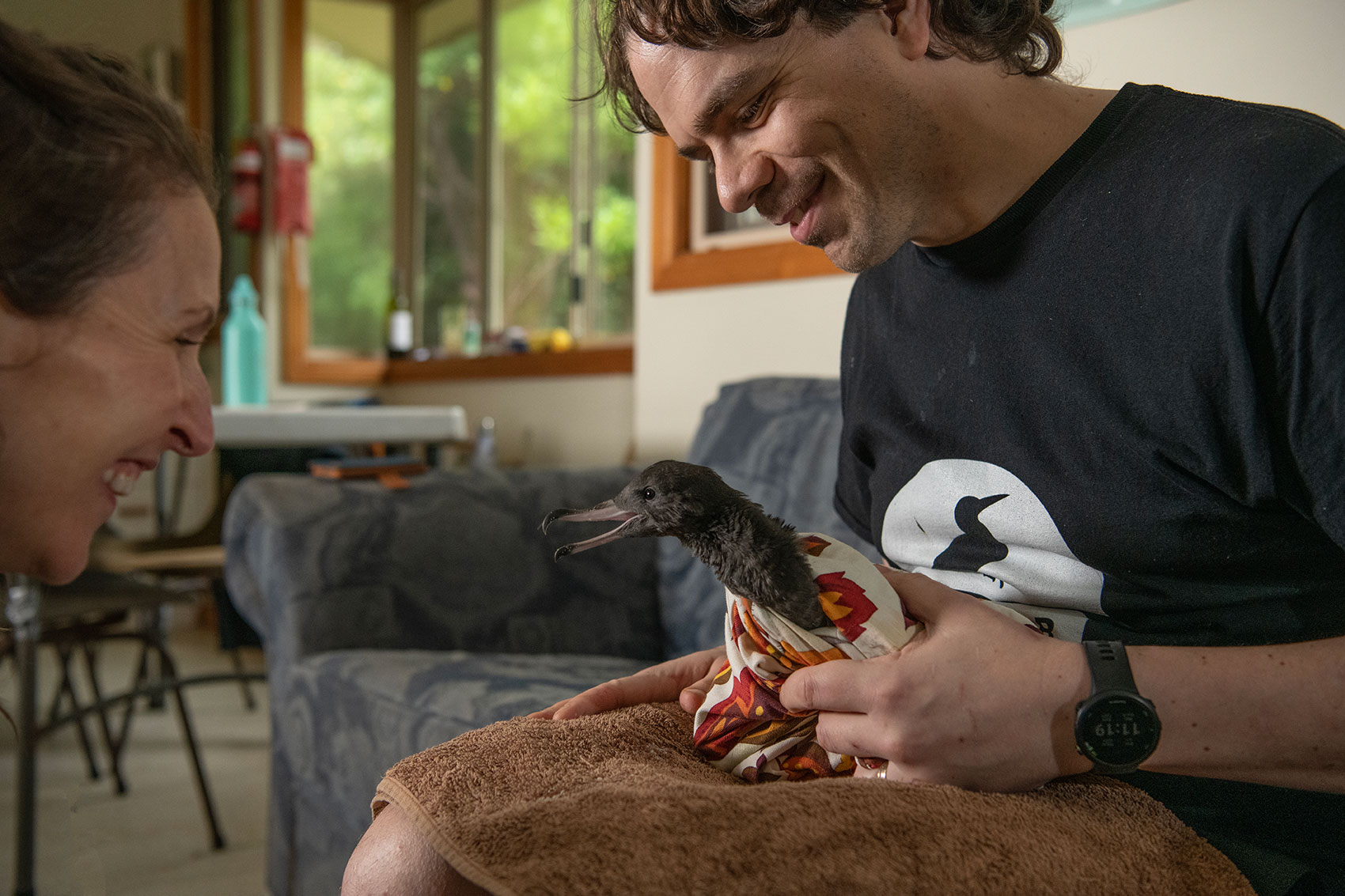
Alex and his colleagues have been returning to study the birds on Lord Howe Island almost every year since 2009.
© Justin Gilligan
Reduce your plastic footprint by cutting down on single-use plastics like water bottles and coffee cups.
Be mindful of where your plastic waste is ending up. Try to recycle plastic where facilities are available.
Report birds tangled in plastic or other debris to help scientists understand more about the scale and spread of plastic pollution.
You can also join a litter pick or beach clean-up near you. For UK residents, the Great British Beach Cleanopens in a new window takes place each September.

Use our tool to find actions that are good for you, your community and the planet.
Join our community of planet fixers
Enter your email to get monthly tips on living sustainably as well as articles, events and information to help you become an advocate for our planet. We may occasionally include information about other parts of the Museum or third-party content from our corporate partners and other museums. We will not share your personal details with these third parties. You must be over the age of 13. Privacy notice.
Follow us on social media